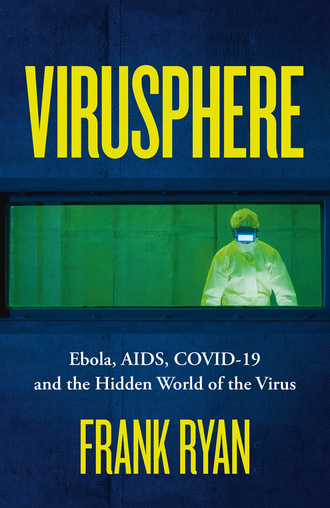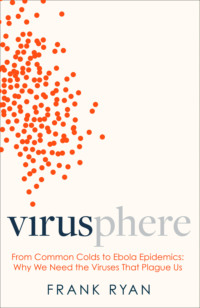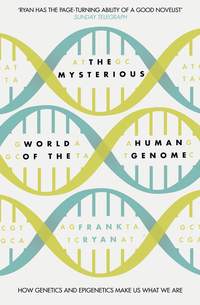
Полная версия
Virusphere
D’Herelle deduced that what he was witnessing was the effects of a bacteriophage virus, which must also be present in the cavalryman’s gut – a bacteriophage virus that was capable of devouring the Shigella germ. But then he had an additional stroke of genius. What if the same thing was happening inside the infected patient? He dashed to the hospital to discover that during the night the cavalryman’s condition had greatly improved and he went on to make a full recovery. At this time bacterial infections, such as dysentery, typhoid fever, tuberculosis and the streptococcus, were a major cause of disease and death throughout the world. With no known antibiotics to treat infections, there was a desperate need for any form of therapy. His observations with the dysentery bug bacteriophage gave d’Herelle the idea that, perhaps, phage viruses might be cultivated with the express purpose of treating dangerous bacterial infections.
During the 1920s and 1930s, d’Herelle conducted extensive research into the medical applications of bacteriophages, introducing the concept of phage therapy for bacterial infections. This therapy saw widespread use in the former Soviet Republic of Georgia, and also the United States, continuing in use until the discovery of antibacterial drugs in the 1930s and 1940s. The use of drugs was much simpler to apply and proved dramatically effective, thus supplanting bacteriophage therapy. But this did not stop d’Herelle from continuing to study this marvellous if deadly entity that was so very tiny that it was completely invisible even to the most powerful light microscope, and yet appeared to be so powerful when it came into contact with its prey bacteria.
In 1926, d’Herelle published a now-historic book, The Bacteriophage, in which he described his work, and thoughtful extrapolations, concerning bacteriophage viruses. As we shall duly discover, the importance of the bacteriophage, as we recognise it today, has eclipsed all that even its pioneering researcher, Félix d’Herelle, could possibly have imagined in those early years.
In retrospect, it is remarkable that, even so many decades ago, d’Herelle clearly grasped that he was dealing with a wonder of the natural world, declaring in his book that these agents that were so dreadfully lethal to bacteria were also capable of exerting an extraordinary balancing effect in the interactions between the bacteriophage virus and its host bacterium. In his words: ‘A mixed culture results from the establishment of a state of equilibrium between the virulence of the bacteriophage corpuscles and the resistance of the bacterium. In such cultures a symbiosis obtains, in the true sense of the word: parasitism is balanced by the resistance to infection.’ This is the first use of the term ‘symbiosis’ in reference to viruses in microbiological history. In a footnote, d’Herelle took the implications further by drawing a parallel between what he was observing in the interaction of the bacteriophage virus and bacterium and the symbiosis that had recently been discovered in all land plants, where fungi in soil invade the plant roots to form a ‘mycorrhiza’, whereby the fungus feeds the plant with water and minerals and the plant feeds the fungus with the energy-giving metabolites that derive from the photosynthetic capture of sunlight. In d’Herelle’s words: ‘The respective behaviour between the bacterium and the bacteriophage is exactly that of the seed of the orchid and the fungus.’
D’Herelle is now recognised by many scientists as the father of both virology and molecular biology. But it would take many years before the world of virology, and microbiology in general, would come to rediscover d’Herelle’s original vision of the symbiotic nature of the bacteriophage.
4
Every Parent’s Nightmare
Parents will be familiar with the anxiety that comes with childhood rashes and fevers. How natural that our hearts should falter with the beloved child tossing in a perspiring fever, the restless anxiety, racking coughs, or sickness and vomiting. We can hardly sleep with worry that something worse might happen in the dark of night. That worry is, perhaps, a residuum of a fear from times only recently gone by when unpleasant things really did happen in the dark of night to those we loved. How fortunate we are now that our families are protected by antibiotics, antiviral drugs and the vaccines that keep such terrors at bay. But these advances are relatively new to medicine and to society. We should not forget that as recently as the 1950s most of humanity, even in developed countries, ultimately died from infection.
Before its prevention, using the triple vaccine, one such major cause of parental anxiety was measles, a commonplace and highly contagious childhood fever. How astonishing it is that this appears to be a relatively new disease in humans. Hippocrates, who wrote about the common diseases in Ancient Greece in the fifth century CE, recorded clearly recognisable descriptions of common infections such as the virus-caused herpes and the protist-caused malaria, yet this very knowledgeable ancient authority gave no description to match the symptoms and signs of measles. It is hardly a disease that would be readily missed, with its striking rash and fever, high contagion and common association with childhood. There is a clue in the name, ‘measles’, deriving from an Anglo-Saxon word maseles, which means ‘spots’. The first written description of measles is attributed to the tenth-century Persian physician, Abu Becr, also known as Rhazes, who cited a seventh-century Hebrew physician, El Yehudi, as providing the first clinical description of the disease. Rhazes recognised measles as an affliction of children and he distinguished it from the equally prevalent but far deadlier rash-provoking disease of smallpox.
Symptoms typically include a high fever, with a temperature often greater than 40°C, a racking cough, runny nose and inflamed eyes. Two or three days after the start of the fever, small white spots on a red inflamed background can be seen in the mucous membranes inside the cheeks. These are known as Koplik’s spots and are diagnostic of the disease. At much the same time a flattish, bright red rash invades the skin, usually beginning on the face and then spreading to the rest of the body. The rash, and causative illness, usually persists for seven to ten days and, in fit and well-nourished children, is usually followed by a full recovery. But in a minority of cases, most commonly seen in malnourished children, and in particular children in less-developed countries with poorly developed health care facilities, measles can lead to serious complications.
Like the common cold, measles is specific to humans, although it can be artificially transmitted to monkeys by laboratory experiment. This means that we are the reservoir of measles in nature – we are the natural host. The only place measles virus can spread its infection, and produce its new brood of new daughter viruses, is in us. It really is that up close and personal. And this means that the relationship – the symbiosis – between humans and the measles virus has been evolving for a long time, and in symbiological parlance with evolutionary implications for both ‘partners’. The causative virus, or morbillivirus, comes in a variety of groups, known as ‘clades’, within the broader family of viruses, called the paramyxoviruses. Individual measles virions are spherical, rather like cold viruses, with a genome made up of a single strand of RNA. The viral genome is contained within a similar capsid type of coat, but in this case the capsid is enclosed in an additional surface ‘envelope’, which carries multiple spike-like projections that play a key role in the infectious process.
Measles is a highly infectious virus with a worldwide distribution, but it can only survive in populations as an ‘endemic’ contagion, in populations where there is a continuous supply of susceptible children. We shall return to this observation when talking about the measles vaccine. The measles virus spreads by aerosol inhalation, much like the common cold. Its initial target cells are, once again, the lining cells of the respiratory tract. But unlike the cold virus, with its focus on the nose and throat, measles heads down into the lower respiratory tract. For some unknown reason, the virus also has a predilection for the cells of the conjunctivae, which explains the inflamed eyes that are a common sign of the clinical presentation. During the first two to four days of infection, the virus multiplies locally in the target cells. The alien presence of the virus provokes local inflammation and this in turn attracts the attention of white blood cells, known as macrophages, which normally gobble up unwanted debris, dead and diseased cells and invading parasites. This process is known as phagocytosis. Unfortunately – or alas perhaps knowing a little about viruses and their behaviour, predictably – these same phagocytes now become the final target cells of the measles virus.
The virus hijacks the phagocytes, invading and then replicating inside them, and then taking advantage of their natural locomotion to the regional lymph glands, where a second phase of viral replication takes place. From the lymph glands, the virus invades another variety of white blood cells, known as leukocytes, and once again it hitches a ride aboard these infected cells into the bloodstream, thus spreading to every cell and tissue, notably the skin. It is at this stage of bloodstream spread, or ‘viraemia’, that the typical rash and high fever appear.
Just as we saw with the cold virus, the measles virus doesn’t have things all its own way. Those same cells targeted by the multiplying virus, the macrophages, are the first line of defence in our immune system. Besides phagocytosis, the macrophages play a critical role in our inbuilt ‘innate’ immunity. They also play a key role in triggering an even more powerful defence system, our ‘adaptive’ immunity, identifying foreign antigens on the surface membranes of the virus as ‘alien’ to the body’s notion of ‘self’, and presenting these foreign antigens to cells, such as lymphocytes, that set off a process of specific immune recognition followed by the production of antibodies to the virus. The antibody response is also combined with yet another key element of our immune defences, known as ‘cellular immunity’. All of these powerful elements of our immune response will ultimately work together to destroy the foreign threat.
Many years ago, as a medical student at the University of Sheffield, I conducted an experiment aimed at testing how the mammalian immune system would respond to exactly such a viral invasion into our bloodstream. With the help of my mentor, Mike McEntegart, Professor of Microbiology, I injected viruses into the bloodstream of rabbits and then observed how the rabbit immune system dealt with them. I started with a primary dose and followed this up a week or so later with a booster dose. Some readers might react with concern about hurting experimental animals, but the virus I used was a bacteriophage, known as ΦX174 – a virus that only attacks E. coli bacteria – so the rabbits suffered no illness. But their adaptive immune system responded in exactly the way a mammalian immune system should respond to any alien invader entering the bloodstream, with a build-up of antibodies in two waves, rising to a peak by 21 days, by which time a single drop of the now-immune rabbit serum was seen to inactivate a billion viruses in mere minutes. With the help of other colleagues at the university, we obtained pictures of what was actually happening under the electron microscope, which showed the syringe-shaped phage virus being overwhelmed with antibody molecules and gathered up in sticky antibody-wrapped aggregates that would have been readily mopped up and cleared from the system by the ever-vigilant phagocytes.
What I observed in the phage virus experiment is similar to what would be expected to happen in a child suffering from measles. There is an incubation period of one to 12 days after exposure to the virus, during which it is passing through the target cells in the respiratory tract, through the lymph glands and entering the bloodstream. At this stage the illness becomes obvious, with fever, cough, runny nose and inflamed eyes. Two or three days later, the Koplik’s spots appear on the inner lining of the cheeks and the rash appears on the face and spreads over a day or two to be confluent over the skin. Ironically the striking symptoms and signs, including the fever and the rash, are actually produced by the attack of the immune system on the virus. Through the actions of that same immune system, the majority of children go on to make a full recovery – after which the immune system retains its memory of the antigens on the surface of the virus. In most cases, this will ensure that the sufferer is resistant to any future infection with measles. But further complications bedevil the recovery in a tragic minority of infected children, which include diarrhoea, pneumonia, blindness and, most serious of all, the inflammation of the brain called encephalitis.
Readers may be astonished to read that before the introduction of the measles vaccine, in 1963, major epidemics of measles swept through the global population every two to three years, causing some 2.6 million deaths. Even today, measles is still one of the leading causes of death in young children, despite the fact that a safe and cost-effective vaccine is available to prevent the infection. Between the years 2000 to 2016, the World Health Organization estimated that measles vaccination had prevented some 20.4 million deaths; but, tragically, in 2016 some 90,000 people still died needlessly from this preventable infection.
Unlike my generation, in which measles infection was commonplace, most parents in developed countries these days will have little or no experience of dealing with measles in the family. This, thankfully, is through the benefit of the MMR vaccination programmes which are now governmental policy in many countries. MMR vaccines protect children against three different viral illnesses: measles, mumps and rubella. But as a result of so-called ‘MMR misinformation scares’, the triple vaccine has been the subject of controversy in different countries, with some misguided parents withdrawing their children from the vaccination programmes.
I shall return to this important topic later in this chapter, but first I would like to examine the other two viruses involved in the vaccine.
The infection we call ‘the mumps’ probably derives its name from an old word meaning ‘to mope’ – an apt description of the afflicted child, struck down by malaise and fever and, a day after the onset, the painful swelling of one or both parotid glands within the cheeks, a condition known clinically as ‘parotitis’. The causative virus, the mumps virus, is another paramyxovirus, which is also global in distribution. Unlike measles, mumps was familiar to Hippocrates, some two and a half millennia ago. Mumps is also specific to and dependent on the human host, which, in symbiological parlance, is its co-evolving partner, and sole natural reservoir. Once more, the mumps virus is usually spread by the respiratory route, but it can also be spread through contamination with virus-infected saliva.
Fortunately, in most cases the illness is quickly dealt with by the immune system, with the symptoms settling within a few days, so that recovery is usually uneventful. In some cases the illness is so slight that the sufferer doesn’t even realise he or she has encountered the virus. But in 20 per cent of males who contract mumps after the age of puberty, the virus causes inflammation of the testes, clinically known as ‘orchitis’. This manifests as local pain, which can be severe, accompanied by the swelling of one or both testes some four or five days after the onset of the parotitis. Though some testicular atrophy may result, thankfully the orchitis doesn’t usually cause subsequent sterility. Though uncommon, mumps can occasionally cause inflammation in the ovaries in females, and equally rarely cause pancreatitis in either sex. Mumps may also cause a viral, or ‘aseptic’, meningitis and, like measles, it may also cause encephalitis. Meningitis and encephalitis are serious medical complications, which will usually result in hospitalisation and, in some cases, mortality.
Rubella, or the so-called ‘German measles’, is not a German contagion at all but rather a globally distributed infection. The illness just happened to be first described by two German doctors back in the eighteenth century. No more does it have anything to do with measles. The causative virus is in fact a ‘togavirus’, and an interesting example of this family of viruses since it is the only togavirus that isn’t spread by biting insects. Rubella is a contagious, generally mild, viral infection that mostly afflicts children and young adults. But if the virus infects women in early pregnancy, at a key time when major embryological development is taking place in the foetus, it can cause foetal death or a range of severe congenital defects known as ‘congenital rubella syndrome’ (CRS). These include hearing impairment, eye and heart defects, autism, diabetes mellitus and thyroid malfunction.
The key fact here is that rubella, like measles and mumps, is exclusive to humans. It means that we are the only reservoir or host of all three viruses – in the symbiological lexicon, we are the exclusive partner. That means that if the reservoir were to be closed down, for example through vaccination, the diseases would disappear.
The risk of all three of these viruses – measles, mumps and rubella – has been greatly reduced in developed countries by preventive vaccination, which, in the UK, the US and many other countries, is achieved using the combined MMR vaccine. It is important, given various misinformation scares, that we grasp the purpose of such a vaccine, and indeed the way in which vaccination works.
Vaccines use either a live, but harmless, variant of a live virus, or a killed virus – or even antigens extracted from parts of a virus – to protect children from the suffering and potential complications of virus infection. The MMR triple vaccine, which employs all three live attenuated viruses – measles, mumps and rubella – has greatly reduced the prevalence of all three viral diseases in the countries where it has been introduced. Unfortunately, a scientifically disproven claim that the MMR vaccine increases the risk of autism has persuaded some parents to forgo vaccinating their children.
People really do need to sit up and take notice of the advice of doctors and health authorities and ignore the misinformation coming from unreliable sources. Not doing so has the potential for unpleasant consequences. In a recent case involving the Somali-American community in the state of Minnesota, the local population, being misguided into believing that the vaccine had increased the frequency of autism in their children, stopped vaccinating their children with MMR. The real truth was exposed by a joint study by the University of Minnesota, the Centers for Disease Control in Atlanta, and the US National Institutes of Health, which showed that the incidence of autism in the Somali-Americans was no different from the vaccinated city’s white population. Alas, in May 2017 Minnesota saw the biggest outbreak of measles in the state for 27 years. State officials recommended that the Somali children be protected as soon as possible with vaccination booster shots.
America is far from alone in the resurgence of this dangerous and highly infectious disease of childhood. In May 2018, the British newspaper, the Daily Telegraph, reported a resurgence of measles throughout the continent of Europe, with the disease increasing in Belgium, Portugal, France and Germany. Once again, the efficacy of MMR vaccination was being undermined by the same baseless linking of the measles vaccine to autism, which had resulted in a rise from a record low incidence of measles Europe-wide, with 300 per cent rise in cases from 2017 to an estimated 21,000 cases in 2018, and some 35 reported deaths. In the UK, following years of similar misinformation about a link between the MMR and autism, many people of late teenage years to early twenties had not been vaccinated in their childhood years, making them now susceptible to this unpleasant and potentially dangerous viral infection. In July 2018 The Times reported a national alert being sounded out to family doctors throughout the UK, warning them to be on the alert for the disease in families returning from holidays in Italy. In England alone some 729 cases had already been reported in the first half of the year, when compared to 274 in the whole of the previous year.
Parents with any due concerns should seek the advice of their knowledgeable family doctors.
5
A Bug Versus a Virus
One of the commonest errors people make in relation to microbes is to confuse viruses with bacteria. It is important that we recognise the differences since this is the first step towards understanding the vital role of the interactions between the two very different organisms – bacteria and viruses – in the great ecological cycles that are central to life on the planet. One of the commonest of bacterial species found in the healthy colon of mammals is Escherichia coli, usually diminished to E. coli. The most widely studied bacterium in laboratory experiments, E. coli is also an important member of the symbiotic gut bacteria, helping in the production of vitamin K and the digestive uptake of vitamin B12, meanwhile also helping to reduce the threat of invading pathogenic bacteria. E. coli colonises the baby’s gut within 40 hours of birth, gaining access through hand-to-mouth human contact – most likely the mother during her fondling and feeding of the child. This, of course, is no threat, but rather the beginning of an important symbiotic interaction between human and bacterium.
The E. coli species is divided into a number of serotypes, most of which are either harmless or symbiotic to humans. This is why contamination of the skin with human waste is a question of hygiene rather than a cause for alarm. However, there are pathogenic serotypes of E. coli that can cause gastroenteritis, and these serotypes may be involved in food scares and product withdrawal from food outlets. More virulent strains of the pathological serotypes can cause urinary tract infections and, rarer still, life-threatening bowel necrosis, peritonitis, septicaemia and fatal cases of haemolytic-uraemic syndrome. Thankfully these serotypes are very rare, so that, under normal circumstances, E. coli is a beneficial contributor to the human gut flora.
Under the light microscope, the bacterium is visible as a single-celled sausage-shaped bacterium roughly 2.0 micrometres long. A micrometre, or μm, is one-millionth of a metre. E. coli has no nucleus and so it is an example of a prokaryote, which translates from the Greek to mean ‘before nucleated life forms’. The bacterial body is enclosed in a membrane, or cell wall, which contains the protein antigens that separate it into different serotypes. The cell wall does not take up the commonly used dye for testing bacterial types, known as a Gram stain, so it is classified as Gram-negative. This same cell wall is capable of acting as a barrier to certain antibiotics, so for example E. coli is resistant to the action of penicillin. Many strains of the bug have flagella and so they can be seen to wriggle about in search of nourishment. The bug is attuned to living in the anaerobic environment of the human intestine, where it sticks on tight to the microvilli of the intestinal wall. When passed out of the body, in faeces, the bug is capable of surviving for some time even when exposed to the oxygenated environment. This is why pathological serotypes can cause food contamination in the home and in food-processing environments.
We are somewhat inclined to see all microbes as potential pathogens. But outside the medical world, microbiologists have long been aware that microbes play much wider roles in nature. For example, the bacteria in soil are essential to the normal cycles of life, helping to break down organic matter to its elemental components, which are then made available for recycling to supply the basic requirements of other living beings. So essential are these soil bacteria that if they were to disappear, the vast majority of life on Earth would follow their example. Such living interdependency is known as symbiosis. We humans are apt to confuse symbiosis with notions of ‘friendliness’ or ‘togetherness’, thereby grafting human attributes onto situations where such human notions do not apply. Perhaps it might be a good idea to clarify what the concept of symbiosis actually means to the biological sciences.







